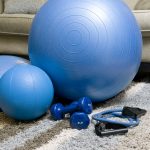One topic that comes up regular as we get older in life is how to prevent Osteoporosis? It is a debilitating condition that affects many of us as we age and particularly if you happen to smoke. It`s absolutely key that to help deter the onset of Osteoporosis you are doing something to help keep your bones strong.
Whether you’re a teenager, middle-aged adult, or senior citizen, it’s never too late to exercise for bone strength. While most of your bone growth occurs before the age of 35 and exercise is most beneficial for bones while you’re young, physical activity continues to strengthen bones and works to prevent Osteoporosis at any age.
How does exercise affect Osteoporosis? Well, its because exercise improves balance, coordination, and strength, it helps reduce the risk of falling and breaking a bone, thus reducing risk of Osteoporosis over the long term.
Two types of exercise are recommended for building and conserving bone density: weight-bearing and muscle-strengthening. As you would expect, anyone with thin or brittle bones should get clearance from a doctor before beginning a new exercise programme. That said, in most cases, low-impact exercises are considered safe, even for those with advanced osteoporosis.

Here’s a look at the best exercises to boost your bones..
Exercises That Bear Weight
Any exercise that requires your body to move against gravity while you’re in an upright position is called a weight-bearing exercise. For these types of exercises, weight doesn’t refer to barbells and dumbbells, but rather your own body weight being carried around by your legs.
Weight-bearing exercises can be high or low impact, but it’s the high-impact variety that is most effective for building bones and maintaining their strength over time.
There are dozens of different kinds of weight-bearing exercises. A few of the more popular high-impact weight-bearing exercises include jogging, running, tennis, dancing, Zumba, hiking, jumping rope, basketball, and aerobics.
To exercise with less stress on your bones and joints, low-impact exercises are recommended. A few examples of these include the elliptical machine, stair-step machine, brisk walking, or golf.
Find several kinds of weight-bearing exercises you enjoy and add them to your workout routine. Plan to do weight-bearing exercises for 30 minutes a day, two to three days a week. You’ll not only strengthen your bones, but you’ll also burn calories, build muscle, help your heart, and stay physically fit at the same time.
Muscle Strengthening Exercises
Many people end up spending most of their workouts focusing on weight-bearing exercises. As a result, they miss out on the amazing bone-building benefits offered by muscle-strengthening exercises. Also called resistance exercise or resistance training, these movements require your body to work against gravity or some other sort of resistance while standing up, sitting down, or lying down.
Strong muscles support strong bones and muscle cells burn more calories than fat cells, so don’t skip these types of exercises. Include them in your workouts at least twice a week for optimal health and lessen the chances of Osteoporosis causes and symptoms.
Strength training, weight lifting, body-weight exercises, weight machines, and using elastic bands are all forms of muscle-strengthening exercises. And don’t assume you can only do strength training at the gym. When bad weather or poor health keeps you home or business takes you on the road, body-weight exercises like push-ups, tricep dips, or planks can be done anywhere, anytime.

Exercise Correctly
Everyone, including those with osteoporosis or those at risk for the disease, can increase bone strength and density with exercises like these.
Work with your trainer or other professionals to develop a weight-training routine that’s safe for you. Proper form is essential for preventing injury and getting the most out of your workout.
Workouts like yoga, Pilates, and Tai-Chi are also great for improving bone health, strength, flexibility, and balance. If you’re living with Osteoporosis, particularly Osteoporosis of the spine, you should only do these workouts under guidance and qualified supervision. Certain movements associated with these workouts puts painful pressure on bones that your trainer will know how to work around.
Bone Building Alternatives
Exercise is good for everyone, whether good bones or bad, but it’s only part of the Osteoporosis prevention and treatment regimen. Other key elements of building healthy bones include eating a diet high in calcium and vitamin D, limiting alcohol consumption, not smoking, and maintaining a healthy weight.
A more detailed look on Osteoporosis treatment guidelines can be found here.
Hopefully this article has given some insight on how to reduce the risk of Osteoporosis, or at least gives you a strategy of helping to minimise the likelihood of developing this unpleasant condition.
Keeping your bones strong and healthy, along with the other recommendations mentioned will stand you in good stead for the future and it is also hoped this article has been of sufficient help on how to prevent Osteoporosis in the years ahead.







Leave A Response
You must be logged in to post a comment.